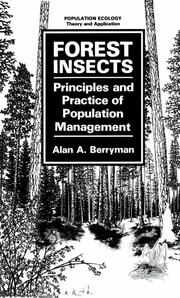Detailansicht
Forest Insects
Principles and Practice of Population Management, Population Ecology
ISBN/EAN: 9781468450828
Umbreit-Nr.: 5647468
Sprache:
Englisch
Umfang: 294 S.
Format in cm:
Einband:
kartoniertes Buch
Erschienen am 12.12.2012
Auflage: 1/1986
- Zusatztext
- This book is intended as a general text for undergraduates studying the manage ment of forest insect pests. It is divided into four parts: insects, ecology, manage ment, and practice. Part I, Insects, contains two chapters. The first is intended to provide an overview of the general attributes of insects. Recognizing that it is impossible to adequately treat such a diverse and complex group of organisms in such a short space, I have attempted to highlight those insectan characteristics that make them difficult animals to combat. I have also tried to expose the insects' weak points, those attributes that make them vulnerable to manipulation by human actions. Even so, this first chapter will seem inadequate and sketchy to many of my colleagues. Ideally, this book should be used in conjunction with a laboratory manual covering insect anatomy, physiology, biology, behavior, and classifica tion in much greater depth-in fact, this is how I organize my forest entomology course. It is hoped that this first chapter will provide nonentomologists with a general feel for the insects and with a broad understanding of their strengths and weaknesses, while Chapter 2 will provide a brief overview of the diverse insect fauna that attacks the various parts of forest trees and their products.
- Autorenportrait
- InhaltsangabeI Insects.- 1 An Introduction to the Insects.- 1.1 External Structure and Function.- 1.2 Internal Structure and Function.- 1.3 Biology and Behavior.- 1.4 Summary.- References and Selected Readings.- 2 Forest Insect Pests.- 2.1 Insects Feeding on Cones and Seeds.- 2.2 Insects Feeding on Buds, Shoots, and Twigs.- 2.3 Insects Feeding on Foliage.- 2.4 Insects Feeding on Trunks.- 2.5 Insects Feeding on Roots.- References and Selected Readings.- I: Insect Exercises.- II Ecology.- 3 Insects in the Forest Environment.- 3.1 Tree Defenses against Insects.- 3.2 Insects and Forest Stability.- 3.3 Insects and Forest Succession.- 3.4 Insects and Forest Productivity.- References and Selected Readings.- 4 Population Dynamics of Forest Insects.- 4.1 Principles of Population Dynamics.- 4.2 Patterns of Dynamic Population Behavior.- 4.3 Classification of Forest Pest Outbreaks.- References and Selected Readings.- 5 Natural Enemies of Forest Insects.- 5.1 Natural Enemy Responses to Prey Density.- 5.2 Vertebrate Predators.- 5.3 Arthropod Predators.- 5.4 Arthropod Parasites.- 5.5 Pathogens.- References and Selected Readings.- II: Ecological Exercises.- III Management.- 6 Monitoring and Forecasting Insect Outbreaks.- 6.1 Extensive Surveys.- 6.2 Intensive Surveys.- 6.3 Damage Forecasts.- References and Selected Readings.- 7 Assessing the Risk of Insect Outbreaks.- 7.1 Risk Assessment Variables.- 7.2 Risk Assessment Methods.- References and Selected Readings.- 8 Prevention of Insect Outbreaks.- 8.1 Silvicultural Practices.- 8.2 Management of Natural Enemies.- References and Selected Readings.- 9 Control of Insect Outbreaks.- 9.1 Principles of Insect Pest Control.- 9.2 Chemical Insecticides.- 9.3 Microbial Insecticides.- 9.4 Behavioral Chemicals.- 9.5 Genetic Manipulation.- 9.6 Physical and Mechanical Methods.- 9.7 Food Removal.- References and Selected Readings.- 10 Pest Management Decisions.- 10.1 Estimating Economic Impacts.- 10.2 Estimating the Costs of Pest Management.- 10.3 Decision-Support Systems.- 10.4 Integrated Pest Management.- References and Selected Readings.- III: Management Exercises.- IV Practice.- 11 The Practice of Forest Insect Management.- 11.1 The Spruce Bark Beetle in Norway.- 11.2 The Douglas-Fir Tussock Moth in Western North America.- 11.3 The European Woodwasp in Australia.- 11.4 Additional Management Problems.- References and Selected Readings.- Epilogue: The Human Influence.- Answers to Exercises.- Author Index.- Taxonomic Index.
